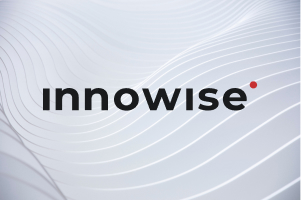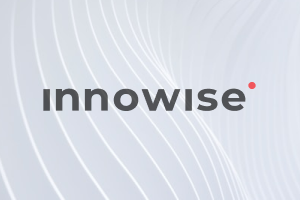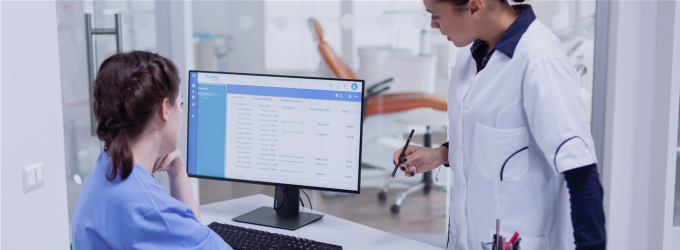Meldingen din er sendt.
Vi behandler forespørselen din og kontakter deg så snart som mulig.
Skjemaet har blitt sendt inn.
Mer informasjon finner du i postkassen din.


Samarbeid med Innowise for å forvandle fragmenterte helsedata til enhetlig, handlingsrettet innsikt og verdibasert omsorg gjennom sømløs EHR-integrasjon, AI-drevet analyse, IoT-data i sanntid og prediktive modeller.
Samarbeid med Innowise for å forvandle fragmenterte helsedata til enhetlig, handlingsrettet innsikt og verdibasert omsorg gjennom sømløs EHR-integrasjon, AI-drevet analyse, IoT-data i sanntid og prediktive modeller.
Innowises tilpassede PHM-plattformer er utviklet for å løse de viktigste utfordringene i dagens populasjonshelseadministrasjon.
Integrer ulike systemer i en enhetlig dataplattform som konsoliderer alle kilder, slik at behandlingsteamene får en fullstendig oversikt over pasientinformasjonen i sanntid og kan forbedre koordineringen.
Utnytt datastrømmer i sanntid fra wearables, eksterne monitorer og live dashbord, slik at klinikere kan overvåke befolkningens helseindikatorer kontinuerlig, med tidlige advarsler (f.eks. et gjennomgående høyt glukosenivå) som utløser proaktive tiltak før tilstanden forverres.
Identifiser høyrisikopasienter tidlig og optimaliser tiltakene for å redusere sykehusinnleggelser og reinnleggelser som kunne vært unngått.
Implementere pasientrettede verktøy (portaler, mobilapper, meldinger) som gjør det mulig for enkeltpersoner å ta aktivt hånd om helsen sin, noe som fører til bedre etterlevelse av behandling og sunnere livsstilsvalg.
Bygg inn samsvar og personvern i alle lag av PHM-plattformen med ende-til-ende-kryptering, tilgangskontroller og kontinuerlig overvåking som beskytter PHI og opprettholder tilliten til regelverket.
Utnytt en skyklar infrastruktur som er bygget for skalering, ytelse og robusthet, slik at du enkelt kan ta i bruk nye klinikker eller tusenvis av tilkoblede enheter uten avbrudd.
Våre plattformer for populasjonshelse er funksjonsrike og skreddersydde til dine behov, og inneholder alle de kritiske funksjonene som kreves for å administrere populasjonshelse effektivt. Hver funksjon er utformet med dyp teknisk innsikt og fokus på brukerverdi.
Vi utnytter avansert analyse for å kategorisere pasientpopulasjoner etter risikonivå. Ved å analysere kliniske data og sosiale determinanter identifiserer programvaren høyrisikoindivider og stratifiserer grupper med lignende helseprofiler. Denne risikoscoringen gjør det mulig for pleieteamene å prioritere tiltak for de pasientene som trenger det mest. Ingen "faller mellom stolene" - alle høyrisikopasienter flagges for proaktiv oppsøkende og forebyggende behandling.

PHM-løsningene våre bryter ned siloene med enhetlige dashbord for koordinering av pleie og omsorg som gir pleieteamene en 360-graders oversikt over pasientens helsetilstand og aktiviteter. Disse dashbordene samler data fra ulike leverandører for å presentere en oppdatert, felles pleieplan. Dette fører til smidigere overganger og mer effektive, teambaserte helsetjenester.

Vi integrerer AI-drevet prediktiv modellering i PHM-programvaren vår for å omdanne rådata til handlingsrettet fremsyn. Analyseverktøyene våre analyserer historiske data og sanntidsdata for å identifisere trender og forutsi potensielle helsehendelser. Prediktive modeller bidrar også til å avdekke mønstre i hele befolkningen. Med denne innsikten kan helseorganisasjoner iverksette målrettede forebyggingsprogrammer og allokere ressurser mer effektivt.

Plattformene våre kan integreres med tingenes internett (IoT) for å muliggjøre fjernovervåking av pasienter i sanntid. Bærbare enheter og hjemmeenheter strømmer data kontinuerlig inn i PHM-systemet. Programvaren genererer øyeblikkelige varsler og varsler til pleiepersonalet hvis noen av målingene faller utenfor trygge områder. Disse varslene gjør det mulig å gripe inn tidlig før en situasjon eskalerer.

PHM-programvaren vår benytter sikkerhetstiltak på bedriftsnivå for å beskytte sensitiv helseinformasjon til enhver tid. Alle data krypteres både under transport og i hvile, brukertilgang kontrolleres via rollebaserte tillatelser, og detaljerte revisjonslogger sporer all systemaktivitet. Vi bygger løsningene våre slik at de er i samsvar med HIPAA og GDPR fra første dag, og vi følger bransjestandarder som HITRUST CSF og ISO 27001 for informasjonssikkerhet.

Vi sørger for at programvaren din integreres problemfritt med eksisterende EPJ, EMR og andre helse-IT-systemer. Ved hjelp av standarder som HL7 v2 og FHIR kobler teamet vårt PHM-plattformen til kliniske datakilder, slik at informasjonen flyter i begge retninger uten avbrudd.

Vi bygger robuste dataintegrasjonsrørledninger som samler inn og forener informasjon fra elektroniske pasientjournaler, helseinformasjonsutvekslinger, skadesystemer, apoteksystemer, laboratoriesystemer og til og med forbrukerapper eller -enheter.

PHM-løsningene våre omfatter intuitive verktøy for pasientengasjement som knytter pasientene sammen med pleie- og omsorgspersonalet. Vi utvikler pasientnettportaler og mobilapplikasjoner som er HIPAA-kompatible og brukervennlige, slik at pasientene kan delta aktivt i håndteringen av egen helse.

Vi utnytter avansert analyse for å kategorisere pasientpopulasjoner etter risikonivå. Ved å analysere kliniske data og sosiale determinanter identifiserer programvaren høyrisikoindivider og stratifiserer grupper med lignende helseprofiler. Denne risikoscoringen gjør det mulig for pleieteamene å prioritere tiltak for de pasientene som trenger det mest. Ingen "faller mellom stolene" - alle høyrisikopasienter flagges for proaktiv oppsøkende og forebyggende behandling.

PHM-løsningene våre bryter ned siloene med enhetlige dashbord for koordinering av pleie og omsorg som gir pleieteamene en 360-graders oversikt over pasientens helsetilstand og aktiviteter. Disse dashbordene samler data fra ulike leverandører for å presentere en oppdatert, felles pleieplan. Dette fører til smidigere overganger og mer effektive, teambaserte helsetjenester.

Vi integrerer AI-drevet prediktiv modellering i PHM-programvaren vår for å omdanne rådata til handlingsrettet fremsyn. Analyseverktøyene våre analyserer historiske data og sanntidsdata for å identifisere trender og forutsi potensielle helsehendelser. Prediktive modeller bidrar også til å avdekke mønstre i hele befolkningen. Med denne innsikten kan helseorganisasjoner iverksette målrettede forebyggingsprogrammer og allokere ressurser mer effektivt.

Plattformene våre kan integreres med tingenes internett (IoT) for å muliggjøre fjernovervåking av pasienter i sanntid. Bærbare enheter og hjemmeenheter strømmer data kontinuerlig inn i PHM-systemet. Programvaren genererer øyeblikkelige varsler og varsler til pleiepersonalet hvis noen av målingene faller utenfor trygge områder. Disse varslene gjør det mulig å gripe inn tidlig før en situasjon eskalerer.

PHM-programvaren vår benytter sikkerhetstiltak på bedriftsnivå for å beskytte sensitiv helseinformasjon til enhver tid. Alle data krypteres både under transport og i hvile, brukertilgang kontrolleres via rollebaserte tillatelser, og detaljerte revisjonslogger sporer all systemaktivitet. Vi bygger løsningene våre slik at de er i samsvar med HIPAA og GDPR fra første dag, og vi følger bransjestandarder som HITRUST CSF og ISO 27001 for informasjonssikkerhet.

Vi sørger for at programvaren din integreres problemfritt med eksisterende EPJ, EMR og andre helse-IT-systemer. Ved hjelp av standarder som HL7 v2 og FHIR kobler teamet vårt PHM-plattformen til kliniske datakilder, slik at informasjonen flyter i begge retninger uten avbrudd.

Vi bygger robuste dataintegrasjonsrørledninger som samler inn og forener informasjon fra elektroniske pasientjournaler, helseinformasjonsutvekslinger, skadesystemer, apoteksystemer, laboratoriesystemer og til og med forbrukerapper eller -enheter.

PHM-løsningene våre omfatter intuitive verktøy for pasientengasjement som knytter pasientene sammen med pleie- og omsorgspersonalet. Vi utvikler pasientnettportaler og mobilapplikasjoner som er HIPAA-kompatible og brukervennlige, slik at pasientene kan delta aktivt i håndteringen av egen helse.

Innowise implementerer aktivt IoT, stordata og AI for å forvandle PHM-programvare fra grunnleggende datalagre til intelligente, proaktive helseadministrasjonsplattformer.
IoT utvider pleien til pasientenes hjem og dagligliv. Ved å kontinuerlig registrere vitale data og kontekst, kan pleieteamene gå fra episodiske kontroller til kontinuerlig synlighet. Vår tilnærming prioriterer pålitelighet, standardbasert datautveksling og varsling, slik at klinikerne kan handle raskt uten ekstra kognitiv belastning.
Populasjonshelse lykkes når alle relevante datapunkter - kliniske data, skademeldinger, sosiale determinanter, enhetsstrømmer og pasientrapporterte resultater - er sentraliserte, styrte og klare for analyse. Vi utformer lakehouse-mønstre og styring som balanserer hastighet med tillit, slik at driftsteam og klinikere kan stole på tallene for å ta bedre og mer informerte beslutninger.
AI flytter PHM fra deskriptiv til prediktiv og preskriptiv. Ved å skåre risiko, oppdage omsorgshull og skreddersy engasjement, hjelper modellene klinikere med å fokusere på de pasientene som trenger oppmerksomhet nå. Vi bygger forklarbare, styrbare modeller med klinisk validering og kontinuerlig overvåking, slik at du kan stole på AI i de daglige behandlingsbeslutningene.

Populasjonshelse lykkes når den er klinisk lett og økonomisk synlig. Vi hjelper teamene med å omsette verdibaserte mål til noen få, enkle arbeidsflyter: prioritere høyrisikopasienter, tette hull i behandlingen, automatisere oppsøkende arbeid og finne de beste tiltakene. Deretter viser vi at programmet gir resultater i form av færre reinnleggelser og lavere kostnader per medlem før det skaleres opp. Resultatet er et program som klinikerne tar i bruk fordi det sparer tid, og lederne støtter det fordi avkastningen på investeringen er målt, styrt og sikker.
Vi bruker en velprøvd firetrinnsprosess som tidlig samordner interessenter, avgrenser integrasjoner og gjør klinikere produktive raskt.
Samordne mål, omfang og KPI-er gjennom workshops og stabelrevisjoner. Du begynner med et prioritert veikart og et business case knyttet til verdibaserte prestasjonsmålinger.
Definere målarkitektur og datamodeller, utarbeide integrasjonskontrakter (FHIR/HL7 v2/API-er) og validere UX med klinikere. Teamene tar beslutninger med en fungerende prototype eller PoV som reduserer omarbeid og sikrer brukervennligheten på et tidlig tidspunkt.
Bygg inntaksrørledninger, MPI-er, analysetjenester og behandlingsmoduler samtidig som du integrerer EHR/HIE/laboratorier/enheter og håndhever sikkerhetskontroller på bedriftsnivå. Du får et produksjonsklart PHM-grunnlag som er testet for ytelse og sikkerhet, og som kan rulles ut med minimale forstyrrelser.
Vi gjør det mulig å ta i bruk plattformen med rollebasert opplæring, støtte ved oppstart, SLA-er og MLOps som overvåker den generelle driftstilstanden. Plattformen forbedres kontinuerlig gjennom effektdrevne forbedringer uten at det går ut over den daglige pleien.
Disse øyeblikksbildene viser hvordan vi gjør folkehelsestrategien om til en fungerende programvare som klinikere kan ta i bruk og ledere kan måle.
Velg en PHM-partner som har erfaring med regulerte helsetjenester, og bygg en plattform som klinikerne tar i bruk, revisorene stoler på og driften er avhengig av hver dag.
Innfør GLP/GCP/GMP-tenkning i PHM, slik at dokumentasjon og dataflyt holder mål. Forvent sporbarhet, endringskontroll og reviderbare prosesser fra oppdagelse til lansering, ikke som en ettertanke.
Utvid teamet ditt med tverrfaglige spesialister fra vår interne pool (dataingeniører, ML/AI, bioinformatikk, klinisk analyse). Skaler raskt opp eller ned for å matche milepæler og holde fremdriften uten lange ansettelsesprosesser.
Gå lenger enn piloter med modellversjonering, overvåking, forklarbarhet, skjevhetskontroller og menneskelig gjennomgang. Du opprettholder oversikten mens modellene brukes til risikoscoring, deteksjon av omsorgsgap og oppsøkende virksomhet i stor skala.
Begynn med et avgrenset brukstilfelle knyttet til verdibaserte beregninger, påvis et løft, og utvid i avmålte trinn. Dette minimerer risikoen og bygger intern tillit med bevis.
Engasjer oss for å levere fra start til slutt, eller engasjer dedikerte ingeniører og forskere sammen med teamet ditt. Modellen tilpasser seg veikartet, budsjettet og hastighetsmålene dine, slik at du beholder kontrollen.

Det var et veldig intenst og effektivt samarbeid, og alle utviklerne var fokusert på målene og forberedt på alle teknologiene vi dekker.

Det jeg synes var mest imponerende med Innowise, var deres evne til å tilpasse seg våre spesifikke behov og samtidig overholde strenge tidsfrister. De kombinerte en kundesentrert tilnærming med sterke ferdigheter innen prosjektledelse, og sørget for at leveransene var av høy kvalitet og i tide.

Vi er imponert over deres fleksibilitet og vilje til å finne løsninger på utfordrende situasjoner. De bistår aktivt i alle slags situasjoner. Teamets vilje til å levere optimale resultater sikrer partnerskapets suksess.
Programvare for populasjonshelseadministrasjon (PHM) aggregerer kliniske og ikke-kliniske data for å avdekke risikoer og muligheter på tvers av definerte grupper, og operasjonaliserer deretter denne innsikten gjennom omsorgskoordinering, oppsøkende virksomhet og rapportering. I praksis gjør dette at du kan stratifisere pasienter etter risiko, tette hull i behandlingen og måle resultatene opp mot verdibaserte mål, samtidig som klinikerne beholder arbeidsflyten sin.
Ja, det gjør vi. Vi designer for interoperabilitet fra starten av, ved hjelp av HL7 FHIR, HL7 v2 og leverandør-API-er for å synkronisere demografi, problemer, medisiner, laboratorieprøver, møter og behandlingsplaner. Integrasjonen kan være toveis, slik at risikoscore og neste beste tiltak vises i klinikerens EPJ, mens PHM bruker oppdateringer med minimal forsinkelse.
Effektiv PHM kommer alle interessenter til gode. Behandlere får tidligere innsyn i forverring og mangler i behandlingen. Omsorgsledere fokuserer på de riktige pasientene til rett tid. Betalerne får kontroll over kostnader som kan unngås, ved hjelp av datadrevne programmer. Pasientene får proaktiv, koordinert støtte som fører til bedre resultater og økt tilfredshet.
EPJ/ EPJ-data, HIE-feeds, betalingskrav, laboratorier, apotek, metadata om bildebehandling, utstyr og RPM-strømmer, pasientrapporterte resultater, sosiale determinanter og offentlige helsedatasett. Verdien kommer fra normalisering av disse dataene til en longitudinell journal som analyse- og pleieteamene kan stole på.
Bestill gjerne en samtale og få alle svarene du trenger.
Bestill en samtaleMeldingen din er sendt.
Vi behandler forespørselen din og kontakter deg så snart som mulig.